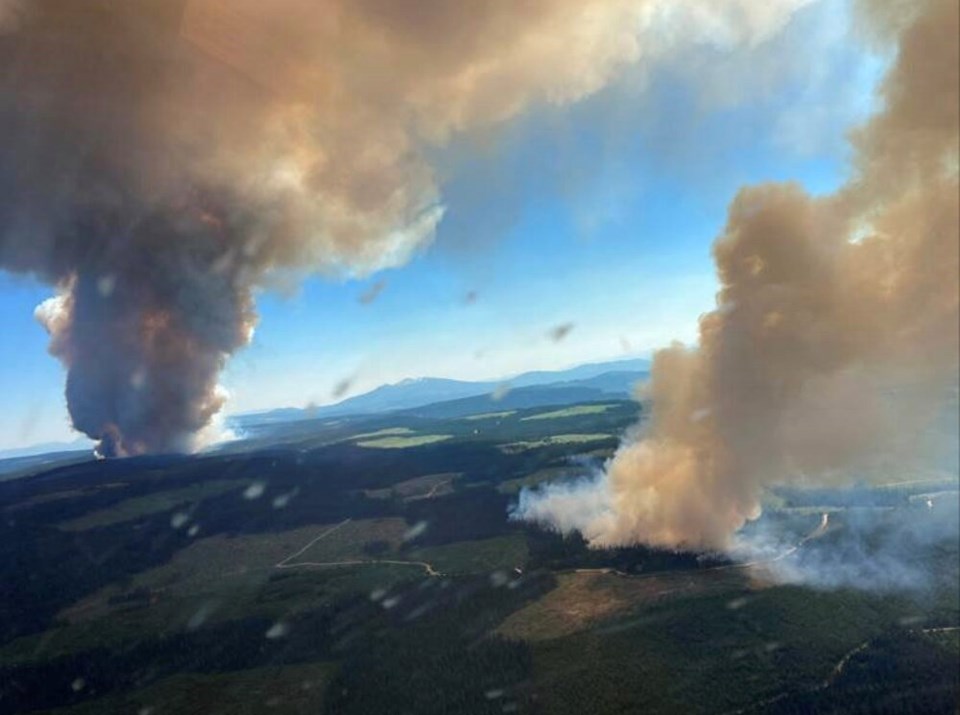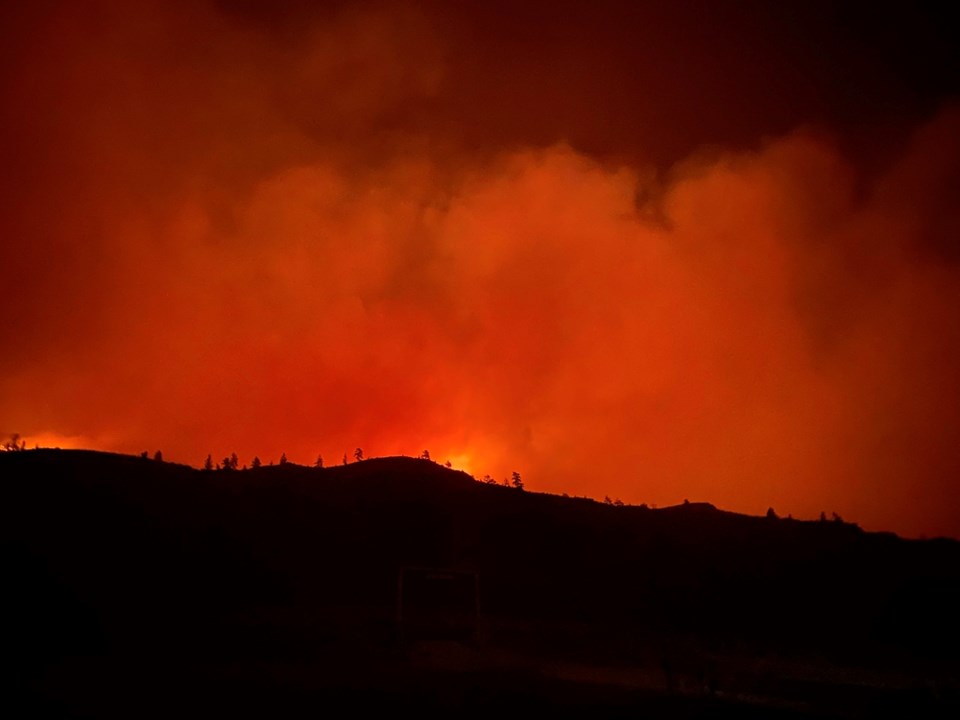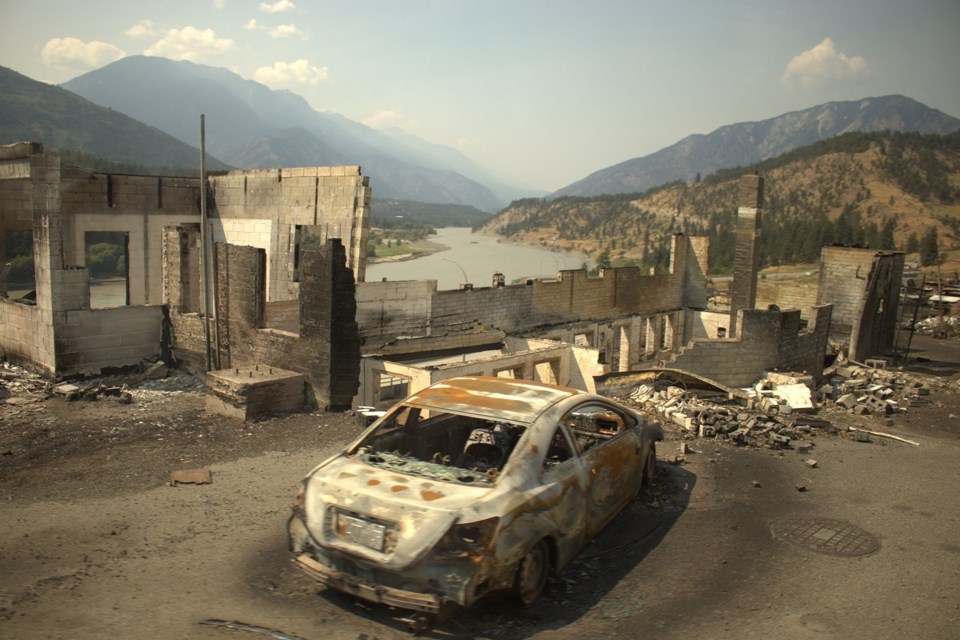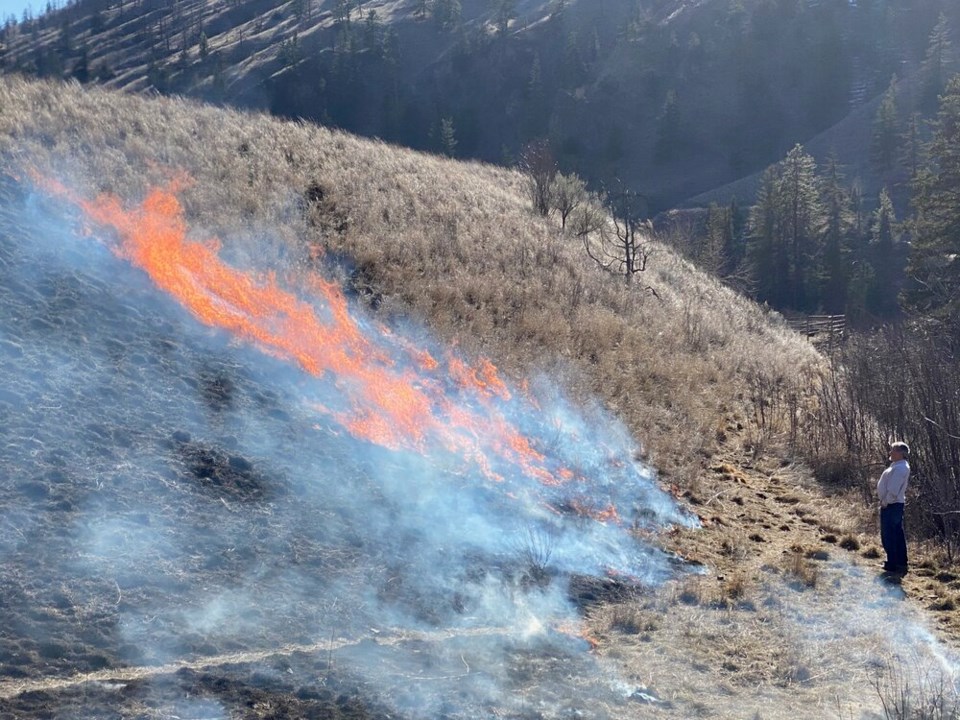Ron Ignace was almost too young to remember the 'cool fires.'
Raised by his great-grandparents in Deadman’s Creek Valley outside of Kamloops, he recalls his great-grandfather setting up a piece of glass in the mountains to magnify the power of the sun.
“He set it up and rode his horse away,” says Ignace, the former chief of the Skeetchestn Indian Band, when recounting the old family story.
Indigenous communities have used fire for thousands of years to ‘’ forests.
“What you're doing is singeing off the old grass, the dead grass from last year, and putting carbon into the ground, and the black soot attracts the heat from the sun and germinates the plants,” says Ignace of the process, also known in Indigenous communities as "cultural burning."
Some communities would burn up a mountain in soil left moist by a retreating snowline, the charred earth stimulating the growth of berry patches or medicinal plants. Others would set fire to the land to open up clogged waterways for spawning salmon or clear foraging areas for moose and deer. The net effect, agree oral histories and forest ecologists, was to suppress mega-fires with low-intensity burns.
On the heels of a record-breaking heat wave that scorched B.C. in a "flash drought," hundreds of fires have exploded across the province — none more iconic than in Lytton, where wildfire devastated the town only a day after it set Canada's all-time temperature record of 49.6 C. Climate experts say the was made 150 times more likely because of climate change, and such heat waves are expected to regularly return as soon as 2040, making tinderbox conditions even worse.
On the ground, the stage is already set. B.C.'s forests are sitting under "immense quantities of fuel," according to a white paper recently published by a number of leading wildfire researchers.
For Indigenous firekeepers like Ignace, cultural burnings offer a solution to the fire problem that has gathered in deadly force for more than a century.
It's time, he says, for the province to fight fire with fire — on a grand scale.
FIRE SCARS
On a spring or fall morning, winds blow from the south up Ignace's 10-acre property. That's when he and his wife, Marianne, drop a match. The fire walks slowly up the valley, singeing away the death. In the afternoon, the winds shift to the north and the firekeeper triggers a blaze at the other end of the valley.
If you time it right, he says, the two fires collide and put each other out.
“It's very straightforward. There's no mystery to it,” he says. “But you have to know the climate, you have to know the winds.”
Ignace says the 15-year “experiment” has brought back two keystone species — the yellow bell and biscuit root, which are important medicine and food plants that haven’t been seen in the area for up to 100 years.
At the same time, Ignace says the forests outside the reserve, where cool burning is effectively prohibited, have become “totally denuded” of biodiversity. Tree species like poplars and birch that once made up a diverse ecosystem but were regarded as “junk wood” have been largely replaced by pine, he notes.
“They’re all growing at the same speed, there’s nothing to break it up,” says Amy Cardinal Christianson, a fire research scientist with the Canadian Forest Service. “It just rips through and keeps burning.”
Christianson says the rise of B.C.'s summer 'hot fires' can be linked to the removal of First Nations from their traditional territories.
The 1862 smallpox epidemic killed an estimated 20 million Indigenous people up and down the Pacific Northwest. The almost unimaginable human toll, what many have likened to genocide, echoed into the natural world. As Ignace puts it, with people no longer on the land to manage fire, “all hell broke loose.”
“That's when the accidental, the hot wildfires increased,” he says.
 Two wildfires north of Big White burn in close proximity on July 7. As of 7 p.m. July 25, there were 258 active wildfires burning across the province. By BC Wildfire Service/Twitter
Two wildfires north of Big White burn in close proximity on July 7. As of 7 p.m. July 25, there were 258 active wildfires burning across the province. By BC Wildfire Service/TwitterOral histories that survived and were passed down to firekeepers like Ignace have been increasingly vindicated by science.
Lori Daniels, a forest ecologist at the University of British Columbia, has spent years tracing the scars of fire over swaths of Interior forest. By drilling tree-core samples, her work has exposed what Ignace and many other Indigenous burners have suspected for generations: pre-colonial forest fires would burn more often, but at low intensities and rarely in the summer months when they were at their most destructive.
“Those fires stopped in the late 1800s. We see the timing when they stopped is when European settlers arrived. Also, when Europeans made it illegal for people to burn,” says Daniels.
“The whole concept is that fire is bad, and that [trees] were resources that were used to drive the economy.”
The Bush Fire Act of 1874 set in motion a series of B.C. government legislation that effectively banned off-reserve cultural burning and favoured putting out fire at any cost. After the Second World War, new technology and a growing workforce supercharged wildfire suppression, says Daniels.
It was not long after that Ignace remembers his great-grandfather stopped burning altogether.
Ignace attended the Kamloops Indian Residential School for several years, the same school where he says his aunt died and where were found in May 2021. At 16, Ignace fled the school 80 kilometres north to hide away with another aunt.
“I went north because I knew they’d come west to [the] Skeetchesn reserve to look for me,” he says.
Ignace worked in sawmills, railways and apple orchards over the next six years before returning to school, first to get his high school diploma and eventually to finish his PhD at Simon Fraser University where he studied Indigenous oral histories.
In 1982, he returned to Skeetchestn as chief, a post he would hold for the next 30 years. Slowly, says Ignace, cultural burning came back to the community, but always limited by the reserve's borders.
B.C. WILDFIRE PARADIGM 'A MASSIVE BLIND SPOT'
Robert Gray, one of the white paper's seven authors, says it’s time for the B.C. government to relinquish its hold on a paradigm that has created a “ticking time bomb” in the province’s forests.
“There’s no grand strategy,” he says. “It is a massive blind spot.”
To stop the biggest fires from spreading, the report says any given landscape must have at least half of its dry undergrowth and downed trees removed through thinning, species conversion or prescribed burning.
From there, a massive investment needs to be made to create economies to remove and process the billions of tonnes of wood fuels sitting in forests.
That means supporting First Nations, those hit hardest by fire, to both defend their own communities and prevent fires in the first place.
“They were burning to create conditions that allowed them to survive on the landscape,” says Gray. “We can learn a lot from that. Then we turn to western science.”
Instead of commissioning another study, the report calls for a large-scale “Herculean effort” beginning over the next two or three years.
Already the fire record shows the area burned per year in B.C. has already doubled since 1970, says Daniels, who was not involved in producing the report but was among its signatories.
“We have a landscape full of bonfires waiting to go off,” she tells Glacier Media.
FIRE HITS INDIGENOUS COMMUNITIES HARDEST
Lytton has been held up as , a window into the devastating fallout from a warming world.
But it wasn’t just the town that was decimated. More than 800 people from surrounding Indigenous communities were displaced by the fire, forced to flee as homes and buildings burned.
Minister of Public Safety Mike Farnworth has since admitted the government failed to properly communicate with the Nlaka'pamux Nation Tribal Council and Oregon Jack Creek Band.
And in Ignace's community near Kamloops, public officials admitted emergency planners failed to properly communicate with chief and council as the Sparks Lake wildfire bore down on the Skeetchestsn reserve and triggered a massive evacuation earlier this month.
Ignace says he watched wildfire light up the ridge overlooking his home. Within hours, tongues of flame had leapt down the valley, threatening the community of 250 people.
In the lead up to the evacuation, current Skeetchestsn Chief Darrel Draney says the First Nation was having trouble getting heard.
“No red shirts anywhere. No aircraft. Not even a visit,” he says.
 On Friday, July 2, fire exploded onto the ridgeline near Ron Ignace's property on the Skeechestn reserve. By Saturday night, when this photo was taken, a wall of fire remained within hundreds of metres of his home. By Ron Ignace
On Friday, July 2, fire exploded onto the ridgeline near Ron Ignace's property on the Skeechestn reserve. By Saturday night, when this photo was taken, a wall of fire remained within hundreds of metres of his home. By Ron IgnaceFire has been anything but a great equalizer.
Indigenous people make up less than five per cent of Canada’s population. But of the 522,000 people evacuated because of wildfire between 1980 and 2020, over a third of those evacuees lived on reserves and nearly half occurred in communities where over 50 per cent of the population was Indigenous, according to the Canadian Wildland Fire Evacuation Database.
Across Canada, the number of reserves evacuated due to wildfire doubled over the past decade; in B.C., that number climbed to 119 per cent.
Indigenous communities are on the front line of wildfires, says Christianson, who manages the database, but are often sidelined when it comes to deciding how to deal with the threat.
“It’s crazy how disproportionately impacted Indigenous people are,” she says.
CALL FOR CHANGE
Once fire crews arrived at Skeetchestn, both sides started working together, with local experts leading tactical back burns to halt the fire's advance.
“Our hunters tell us when the wind changes. They know that. They have to know that. They know where all the water is, where the roads are,” says Draney. “Skeetchestn is the brains of this fire. The ministry is the brawn.”
So far, firefighters and the First Nation have been able to keep the Sparks Lake fire from burning the homes of the Skeetchestsn First Nation in what Draney says "should be a precedent that's set."
Outside an emergency, the process to approve prescribed burns off-reserve can be daunting, and experts interviewed for this story say cultural burning remains marginalized and limited to reserves in most communities.
“We kind of have this centralized system, and the impact on Canadians shows it’s not working out well,” says Christianson, pointing to the growing number of Indigenous people evacuated due to wildfire every year.
She says she's worried it’s going to take a massive inferno on the scale of the 2019-20 Australian bush fire season for the government to take serious action. As one survivor of the Lytton fire put it, “It's not just going to be us. It's going to be multiple towns burning to the ground if nothing changes.”
 Residents had just minutes to evacuate Lytton on June 30. By Sydney Chisholm / Castanet
Residents had just minutes to evacuate Lytton on June 30. By Sydney Chisholm / CastanetThe province is not blind to the problem. After the devastating 2017 wildfire season, which threatened several First Nation communities including the Skeetchestn Indian Band, the B.C. government recognized it needed to ramp up with Indigenous communities as they "have been doing for millennia."
While flagged , the BC Wildfire Service (BCWS) now publicly acknowledges prescribed burns help the province improve air quality and climate action targets by replacing mega-fires with frequent low-intensity fires. Last month, the B.C. government released an ‘’ on forestry management as well as a to meet its obligations under the United Nations Declaration on the Rights of Indigenous Peoples (UNDRIP). Both underscore the importance of reviving cultural burning to prevent wildfires.
“There's a huge opportunity,” says Cliff Chapman, director of provincial operations for BCWS. “And really now it's about doing that at scale and ensuring the funding mechanisms are in place so that every community can do that.”
There’s also a long way to go.
Between 2010 and 2019, an average of 5,000 hectares were burned in prescribed or cultural fires across the province. That’s less than 1.5 per cent of the yearly average of 350,000 hectares of forest scorched by wildfire over the same decade, according to Tyler Hooper, spokesperson for the Ministry of Environment and Climate Change Strategy.
In 2020, those already low numbers plummeted. The COVID-19 pandemic and prevailing weather conditions meant that the area treated by prescribed fire in B.C. dropped by 86 per cent, according the ministry.
The ministry spokesperson said it’s working with First Nations communities “to get burn projects off the ground” and has spent $7.7 million to do that between 2019 and 2021. Another $50 million has been allocated over those three years to reduce wildfire risk on Crown land.
But experts like Gray say that's not nearly enough, and it fails to consider a drawn-out burn permitting process that keeps many Indigenous firekeepers off wide tracts of land bloated with wood fuel.
PERMIT PROCESS DELAYS ACTION
Getting approval for a prescribed burn requires filling out a . That plan includes precise scientific measurements of the landscape, soil and plant life.
Because the province considers burn plans the practice of , they must be signed by a licensed forestry professional.
Part of the reason is to ensure safety. Burn permits take into consideration a range of conditions on the ground and in the air to ensure ecosystems aren’t damaged and communities aren’t bombarded by smoke or threatened by out-of-control fire.
“There’s a 'Goldilocks' range of conditions that produce the right outcomes — fire that burns what we want to it to burn, at the right intensity, for the right duration,” writes Hooper.
Anyone applying for a burn plan must develop and submit it, and receive an official’s approval in writing 60 days before the proposed ignition. But in practice, the process takes much longer, says Ignace.
Even the Ministry of Environment admits the planning process for a prescribed burn “takes six months to multiple years.”
All of that, says Ignace, makes scaling up cultural burning under current laws next to impossible, especially when, every year, a changing climate makes it that much harder to gauge when to burn safely like his great-grandfather did before him.
“Unless the government wakes up and transforms its forest management practices, revolutionizes it back... We are yet to see the mother of all fires in British Columbia,” he says.
Stefan Labbé is a solutions journalist. That means he covers how people are responding to problems linked to climate change — from housing to energy and everything in between. Have a story idea? Get in touch. Email [email protected].
by on Scribd



